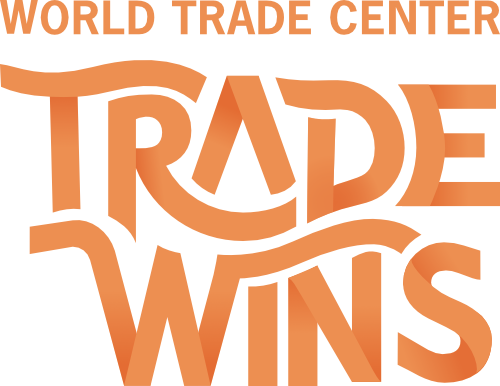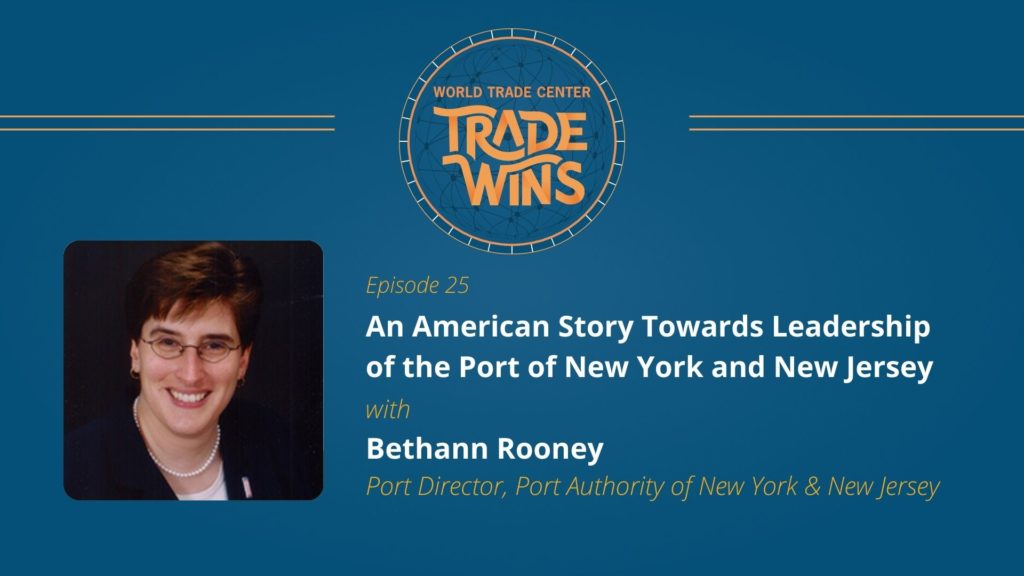Robin van Puyenbroeck 0:08
Welcome back to Trade Winds. I’m Robin van Puyenbroeck, your host, and my guest today is Bethann Rooney, who is the Port Department Director at the Port Authority of New York and New Jersey. So Beth, good to see you again.
Bethann Rooney 0:21
Good to see you. Good afternoon. Thank you for having me.
Robin van Puyenbroeck 0:24
Of course, welcome to the show. So I always like to start by asking people to say a few words about themselves. Tell us a little more about this incredible journey that you had at the Port Authority. I looked up some of your bio, of course, and it seems that you started at the Port Authority in 1993. So I’m very curious to hear this amazing story on how you became the Director of the port in New York and New Jersey.
Bethann Rooney 0:55
Well, thanks for asking. And it really is and has been an incredible journey. Really never in my wildest dreams. Certainly, when I was young, did I imagine that I would ever be in this industry, let alone in such a job of great responsibility in what by far is the greatest court in the United States. In high school, I thought that I was going to go to an all-women’s Catholic college to study accounting, and, at the very last minute, decided to go to a practically all-men’s paramilitary college, and that was the State University of New York Maritime College in the Bronx. And I was, when we started, one of 28 women, less than 10% of my class. And I believe we only graduated with eight women in 1991. At the Maritime College, you are not only getting a degree in either marine transportation or oceanography, or any number of fearing-type programs, but you’re also earning a license from the United States Coast Guard as either a third mate or a third engineer. And by the time you’re done with college, you have the credentials, God willing, to help navigate or control the power plant to move ships around the world. And during that time, you have the opportunity to sail on the school’s training ship each summer. And if you’re lucky enough to go out as a cadet observer on commercial ships, so I had the opportunity to do all of that and thought that I was going to sail professionally for a long, long time, I had dreams of becoming a captain, and being in command of a ship, and instead now I am in command of a port. So I wound up not being able to sail on my license because of my eyesight. And when I graduated from Maritime College, I became a port agent, a port Captain vessel agent – worked in a number of ports around the United States, mostly on the U.S. East Coast being a representative of either the ship owner or the cargo owner. And then after doing that for a couple of years, I joined the Port Authority at an entry-level operations job at our facilities in Port Newark-Elizabeth. And then, lucky for me, I had amazing mentors in the Port Authority who saw far more in me than I saw in myself, and they continued to provide opportunities for me and open doors for me, and doors that I had no desire to walk through, to be honest. I wound up doing a wide, wide variety of things in the Port Authority. After operations, including property management, leasing, intermodal development, I bought barges and cranes and did procurement and I did technology to make the port more efficient and more productive. And then 9/11 happens. And I was not in the Trade Center that day, I was in Washington, D.C. But I came back the morning after, I walked into the port which had been shut down. I got a hug and a kiss from the Port Director at the time and he said you’re in charge of security – a rather overwhelming moment, particularly since I had no security background or knowledge or training—
Robin van Puyenbroeck 4:43
But you knew the port.
Bethann Rooney 4:45
Yeah, yeah, certainly nothing I signed up for but I spent another 14 years then doing maritime security and emergency management and set up what are now world-renowned, award-winning programs that are just very, very widely recognized. And then, while I was doing that, the port experienced what was the worst congestion in our history, believe it or not, even worse than what we’re experiencing right now. And the Director suggested to me just in a casual conversation, what he thought we needed to do to try to wrap our arms around the problems we were experiencing at the time, and I didn’t really think that it was the best idea. And I told him as much and he asked me what I would do differently. And I’m like, I really don’t know. But let me think about it. And I thought about it over the weekend and prepared a white paper. And by the end of the following week, we were implementing what was the Port Performance Task Force, which is to date—
Robin van Puyenbroeck 5:46
Is that from the council group performance that you would architect?
Bethann Rooney 5:49
Correct. So the Port Performance Task Force was a six-month study. After the six-month study, we turned it into the Council on Port Performance. And from there, I established a new job for myself and became the Assistant Director for strategy and innovation, and was responsible for port performance and goods movement and our environmental program, legislative and regulatory affairs, did that for several years. I had the opportunity to become Deputy Director, and number two in the port, and then just recently on May 2nd, became the Director. So it has been just a really, really rewarding and challenging and exciting career. I’m very humbled to be able to be the Director of the Port of New York and New Jersey, and looking forward to all of the challenges that come along with it, we’ve got our work cut out for us. But most importantly, we’ve got an incredible team of folks, both internal to the Port Authority, and within the larger port of New York and New Jersey, that are working to ensure that the port is the premier gateway in the United States. So I am excited.
Robin van Puyenbroeck 7:09
It’s an amazing journey. When we last met in April of this year, I think you’d just received news about your appointment. And you were speaking about your work at the port at the World Trade Week event here in New York and I was glued to many of the things that you were talking about. Because people see ports from a distance, of course, and maybe sometimes a cruise terminal, or you fly over a port. But I think it’s just fascinating. There are a million things that are happening all at the same time, right, at a port. And I remember you were talking about some anecdotes of how to make ports more efficient and how some seemingly small issues actually have a big impact on the efficiency of the port. Are there some of those examples? Because I’d like for you to talk a bit more about sort of, what is it like to run a port the size of New York and New Jersey, it is just massive, right? It just, it’s everything. And then on top of that, consumers are experiencing, sort of, issues in the supply chain and we read about this every day. But what is then looking at those very practical issues that you’re encountering at the port level, how does it tie into the bigger sort of supply chain challenges that we’re seeing today.
Bethann Rooney 8:21
So the good news, if there is any for me, is that the Port Authority is a landlord. So, in New York and New Jersey, there are other port authorities and other ports that are operating ports. So in our case, some might say our job is a little easier. And some might say it’s a little more complicated. But in our case, we’re not directly involved in the movement of cargo. And as a result, we have absolutely no control over the movement of cargo. And yet, it is in our best interest to ensure that the cargo moves through our facilities in an efficient, reliable, sustainable, safe, secure method. But I don’t have any control over any of it. So that comes with its own challenges. What we are first and foremost as the Port Authority, you can think of your local town, so our General Manager of the facilities is the mayor. They’ve got a police department that supports them, and they’ve got the equivalent of a public works department and the equivalent of the buildings department and the equivalent of the highways department, right. So, we’re operating or maintaining the infrastructure of the facilities that serve the movement of the cargo. So, we work with our partners on the infrastructure that supports the port, and then our tenants, our direct customers that we have leases with, actually operate the facilities that move the cargo. And they, in turn, so our container terminal operators, for example, they’re the ones who have an agreement with the ocean carrier, the owner of the vessel. And the owner of the vessel has the agreement with the owners of the cargo that are moving their goods and individual containers or in the case of automobiles with individual units of automobiles or cruise passengers, whatever the case might be. So the job is challenged because we have no official contractual relationships with any of the partners in the supply chain, with the exception of the entity that we hold a lease with. And yet, we need to have all of the partners in the supply chain kind of rowing in the same direction in order to provide for that fluidity and efficiency. So relationships become extremely important.
Robin van Puyenbroeck 11:16
So you are the mayor of the ports, that’s what it is.
Bethann Rooney 11:19
Yeah, it is. There’s no rocket science to what we’re talking about. But since the beginning of the pandemic, I’ve been talking about the three C’s: coordination, collaboration, and communication. And they have been vital, absolutely vital, to being able to manage through a crisis and, and a crisis that the port was sitting in the middle of the epicenter of, of the pandemic, in the early days, when everyone else was sheltering in place and going home, port workers, longshoremen and women, truck drivers, the terminal operators and all the various service providers that helped move the cargo just like firefighters, law enforcement, nurses, doctors were going to work. And not giving any consideration to it, right, because the port as a vital lifeline was critical to ensuring that many of the medical supplies, right, many of the personal protection equipment that needed to get to the frontlines was moving through our port facilities.
Robin van Puyenbroeck 12:34
Yeah, of course. Coming back to your three C’s, on all that coordination and communication, what’s the secret sauce here that you have applied to— which obviously, you were successful in doing this because you can’t enforce that coordination. You can’t force your tenants, your terminal leasing operators to do certain things. I would think, so how do you get everybody to move in the same direction and get everybody’s ear? And how do you coordinate all those different actors?
Bethann Rooney 13:05
So if I go back to when we started, the Council on Port Performance, it was not easy. You are talking about entities that are fierce competitors with each other. We’ve got six different terminal operators, there are 3,000 different trucking companies. And I could go on. There are just a lot of partners that are in fierce competition with each other. And there are entities in the supply chain that have no business relationship with each other, but are dramatically affected by the action or inaction of an entity that they don’t have a relationship with. So at the beginning of these conversations, it was about education and breaking down the walls to the silos. And it took months and months and months of conversations – where in the past an entity or a sector in the supply chain were experts in that sector of the supply chain and didn’t know too much about what happened upstream or downstream from that node, and they didn’t really care.
Robin van Puyenbroeck 14:26
That’s amazing. You would think that they’re very well tuned into what happens upstream, downstream, right? But you’re saying that was not the case.
Bethann Rooney 14:34
Right. Because most businesses are myopic, and they look at, “this is what I’m responsible for and I’m going to focus on what I’m responsible for. And I’m going to do it to the best of our ability and we’re going to provide the best whatever it is that we can” and they don’t necessarily think about if I turn this valve and I changed things a little bit within my purview, how does what I changed, optimize my part of the business have an effect on somebody else. So, the early parts of those conversations were about breaking down those walls, and allowing folks visibility into how the other sectors of the supply chain work, and what makes them tick. And an understanding – and this was the key – is that we all are working for the good of the Port of New York and New Jersey because if one terminal loses a large customer, then it’s not just for that terminal to lose the customer, it’s for the truckers that serviced that customer, it’s for the chassis providers that provided the wheels to that customer, it’s for the Port Authority, and it’s for the warehouses that would service that cargo. And believe me, it is not perfect and we still have our challenges. But recognizing that what we do has an impact on the larger gateway was very important to get folks to collaborate and communicate and coordinate with each other. So I’ll take you back to the just the very beginning of the pandemic, and when things were shut down, and everybody was sheltering in place. Conventions and hotels and conferences are all closed, right? Ports are open, terminals are continuing to handle and receive cargo. And the Council on port performance is getting together and we’re talking and we’re trying to project what’s going to happen. And we collectively identify that if all the retail stores are closed, and people aren’t buying, then the cargo that is already on the water is going to pile up, the warehouses are going to get full, and there’s gonna be no place left to bring the containers. And it’s going to back up into the terminals. And when it backs up into the terminals, it backs up onto the waters. So what did we do? Collectively, we went out and we pulled our resources. And we scoured the region to identify every square inch of open area, land or warehouse space that people had available. And we made an inventory. And I think we had over 90 individual parcels of space networked. And then as things began to back up, folks would reach out to our business development or industrial relations staff. And they said, “hey, my warehouse is out of space, I need more room, do you have any more? Do you know of any?” Then we made marriages between those who had it and those who needed it. And all of that was designed around making sure that the Port of New York and New Jersey remained fluid. Throughout the first almost two solid years, the port of New York and New Jersey was fluid in spite of an increase in cargo, the first year of 10% in 2020 and 18.5% in 2021, and almost 11% year-to-date in 2022. So right now, we are handling 30% more cargo than we were prior to the pandemic.
Robin van Puyenbroeck 19:11
That’s a huge number, huge increase. And do you also face some of the issues of finding and especially retaining workers at the port? Because that’s something that to come across over is from truck drivers to warehouse handlers and what have you. How do you manage the 30% growth? With what kind of staffing?
Bethann Rooney 19:29
That has been a challenge and it has certainly contributed to some of the problems that we’ve had. So if you go again, go back to the beginning, what we saw was a precipitous drop-off in the amount of cargo – tunes of 30-40% drop-offs in the early days and months of the pandemic and at that time, warehouses, for example, were laying off workers. There wasn’t enough cargo to keep them busy. And then we saw a very rapid bullwhip recovery starting in July, August of 2020 that just kept on growing and has continued to grow at rates beyond those that we’ve ever imagined. So when we started that, that fast recovery, folks were still home. They were collecting unemployment, and they were collecting their MIC-related incentives. And as a result, things were not moving as quickly as they needed to move. So, definitely the workforce has been a challenge. I think, just as you see what’s going on nationally, where the unemployment levels have dropped off quite a bit, many of those workers have come back to work, we never had a problem in terms of the waterfront workers. ILA men and women were on the job every single day, and just did an extraordinary job keeping the port open and keeping the cargo moving. We also saw – during the height of the pandemic– we also saw an increase in the numbers of truck drivers, not staggering numbers, but we didn’t lose total overall numbers the way that some other people have. But the challenge, Robin, is a 30% increase since 2019. In cargo volume, we’re handling the activity that we did not project to handle until 2026 or 2027. And thankfully, at our port facilities, we had the capacity to handle that increase in activity. But the rest of the supply chain has not and the rest of the supply chain has not had the time, the warning to make the investment in it. And then, and when do you make the investment? And if you talk to any of the chassis providers, for example, they want to make the investment. But there are raw material shortages, and there are supply chain challenges. So they can’t make the investment as quickly as they would like to and then, do you build the church for Easter Sunday and Christmas? Or you build up your church for your regular Sunday attendance. So, each sector of the supply chain has needed to decide in all of this – is this volume going to stay as high as it is right now?
Robin van Puyenbroeck 22:39
And that’s exactly what would be my question – 30%, how sustainable is that? Because I was recently also speaking to some people in the distribution mainly in cold storage and shipping food produce. And they said, “well, any given day, we have 10 truck drivers just not showing up. And then I have 10 containers with produce that can be shipped and it’s not like the next day we’ll just have 10 more drivers come and ship it out.” So the backlog creates an issue, then they don’t have enough mechanics to fix the trucks. The turnover rate is 100% in the warehouse. People stay on the job for three weeks on average sometimes, so I can only imagine.
Bethann Rooney 23:18
Yeah, people have choices today. People have choices today that they didn’t have.
Robin van Puyenbroeck 23:22
Yeah, it seems like people are just not willing to take the jobs for the money that’s being offered. And then to your point, if you didn’t have to invest in and build a church for – are you making those big capital investments while you’re basically putting out fires every day 24/7 with those types of challenges? And also not knowing is this type of craziness so to speak – is this sustainable? Right? Are things going to really calm down as we’re going into a more sort of recessionary environment that we’ll see what inflation will do and the impact on consumer behavior and what have you. So how sustainable is this situation today? Will it just all melt down so to speak, and everybody will come back to their senses? Or is this a new normal, that there are just not enough people? I believe Forbes made a publication saying that the critical work is in the logistics. The issue is we’re going to be short over 2 million jobs by 2030. Which is a staggering number. Like you don’t just fill that gap, I believe it’s like over 150,000 just for truck drivers. So where do you get – this is not just people hopping in a truck. This is also hard labor, right? It’s hard work loading, unloading. And pay is already at elevated levels. So where do you get the people to take on those jobs and train people so they’re actually skilled for the jobs that are needed?
Bethann Rooney 24:44
You talk about the workforce issues and we’ve been focused on workforce and workforce development as a component of the Council of Port Performance for the last four or five years. And we were doing it based on what we anticipated was the retiring of the workforce and some growth. So we’ve been working with high schools, with community colleges because who grows up and chooses to any longer? Who chooses to be a truck driver?
Robin van Puyenbroeck 25:24
You wanted to be an accountant and look at what happened.
Bethann Rooney 25:27
Right, exactly. Most of the people in the industry, the vast majority of the people in the industry, didn’t grow up wanting to do this, or even go to school for it. They went to school to study management or outdoor operations or engineering, and they just stumbled upon the industry. So, we feel that, and the Council of Port Performance feels that, we need to do more and do better to educate folks about the industry and to begin to interest young people into the wide variety of jobs and careers – some requiring a college education, but many not. So, so we have a number of programs, with local high schools, where we’ve helped develop curriculum and provide mentoring programs and summer internship programs and port tours and opportunities to come to the facilities, virtually during the pandemic, but we provided classroom instruction virtually, and the teachers loved it, right, because they were looking for all the help, they could get with content sometimes. And then we’re educating the public through community centers, one-stop centers. Elks clubs, or Knights of Columbus, whatever it is, educating folks about, “here’s the port, here’s what happens, here’s how important it is to you.” And it is that thing that everybody took advantage of, until they didn’t know where their next roll of toilet paper was going to come from. And then the third part of our workforce development program is focused on job fairs and career fairs – connecting the unemployed or underemployed with opportunities to meet with employers, and also providing opportunities for folks to just become aware of a number of the different types of jobs, right? You can drive a truck, you can be an engineer on a train, you can be sorting cargo pick and pack operations at Amazon or you can be a crane operator unloading the ships, or you could be the ship captain as I wanted to be or the tugboat captain. There are just so many options.
Robin van Puyenbroeck 28:03
It’s its own whole ecosystem. Thank you. Before wrapping up, I always like to end with a final sort of a question. Is there any anecdote that you can share something you’ve encountered over the years at the port – a situation or something where you thought, “Oh, my God. I never thought I would ever come across this type of situation” that you had to resolve where you came across like something anecdotal. I’m sure you have a phonebook full of them.
Bethann Rooney 28:29
It’s every day. It really is.
Robin van Puyenbroeck 28:34
What happened today?
Bethann Rooney 28:36
I have done a lot of reflecting back on my almost 29 years with the Port Authority and 30-something in the industry. It really is something different every day, and I have had the opportunity to be a part of the best of times and the worst of times in the industry. I can remember and I was involved in planning the event for the arrival of the Regina Mares, a 64,000 TEU vessel that, in the early 90s, was supposed to be the largest vessel ever to call the Port of New York and New Jersey and the United States. And by the time we were done deepening the channels to 50 feet, we were handling ships that were already 10,000. I planned the events associated with the completion of the raising of the Bayonne Bridge that allows ships over 18,000 TEUs to come into the harbor. I’ve been there when ships have been arrested and crew members have not been taken care of by the owners of the vessels for weeks or months at a time. I’ve been part of bringing derelict facilities back online to bring manufacturing back to New Jersey for wallboard and gypsum board, for example. I mean, I could go on and on and on about the numbers of things that I’ve been able to do just testifying before Congress. In the days after 9/11, I was 30 years old, a rookie, and I was testifying before Congress about national security issues. What an awesome responsibility and just a privilege to be able to do something like that.
Robin van Puyenbroeck 30:40
Yeah. I see a book in the works.
Bethann Rooney 30:42
No, definitely not. Unless Amanda’s gonna write it for me. I need somebody to write it for me.
Robin van Puyenbroeck 30:47
I’m sure Amanda is taking notes every day. Well, good. Well, Beth Rooney, Port Director of the Port Authority of New York and New Jersey, thank you so much for being on the show. Very much appreciated, and we keep counting on you for the fluid flow of logistics. Thank you so much.
Bethann Rooney 31:06
Thank you, Robin. Great talking to you.
Robin van Puyenbroeck 31:08
If you have any ideas for future episodes, know someone who would be an inspiring guest, or just want to stay apprised of our show, please make sure to connect with our team via email at podcast@wcta.org. Be sure to head over to podcast.wtca.org and subscribe to the show. We will see you soon.






